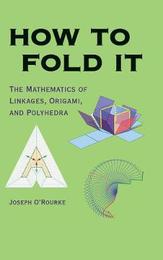
|
How to Fold It: The Mathematics of Linkages, Origami, and Polyhedra
Hardback
Main Details
| Title |
How to Fold It: The Mathematics of Linkages, Origami, and Polyhedra
|
| Authors and Contributors |
By (author) Joseph O'Rourke
|
| Physical Properties |
| Format:Hardback | | Pages:192 | | Dimensions(mm): Height 236,Width 157 |
|
| Category/Genre | Algebra
Geometry
Popular science |
|---|
| ISBN/Barcode |
9780521767354
|
| Classifications | Dewey:510 |
|---|
| Audience | | General | | Tertiary Education (US: College) | |
|---|
| Illustrations |
Worked examples or Exercises; 1 Tables, unspecified; 171 Plates, unspecified
|
|
Publishing Details |
| Publisher |
Cambridge University Press
|
| Imprint |
Cambridge University Press
|
| Publication Date |
25 April 2011 |
| Publication Country |
United Kingdom
|
Description
What do proteins and pop-up cards have in common? How is opening a grocery bag different from opening a gift box? How can you cut out the letters for a whole word all at once with one straight scissors cut? How many ways are there to flatten a cube? With the help of 200 colour figures, author Joseph O'Rourke explains these fascinating folding problems starting from high school algebra and geometry and introducing more advanced concepts in tangible contexts as they arise. He shows how variations on these basic problems lead directly to the frontiers of current mathematical research and offers ten accessible unsolved problems for the enterprising reader. Before tackling these, you can test your skills on fifty exercises with complete solutions. The book's website, http://www.howtofoldit.org, has dynamic animations of many of the foldings and downloadable templates for readers to fold or cut out.
Author Biography
Joseph O'Rourke is Professor and Chair of the Computer Science Department, a Professor of Mathematics, and Director of Arts and Technology at Smith College. His research is in computational geometry, developing algorithms for geometric computations. He has won several awards, including a Guggenheim Fellowship in 1987 and the NSF Director's Award for Distinguished Teaching Scholars in 2001. He has published more than 145 papers in journals and conference proceedings, more than 30 of which were coauthored with undergraduates. He has taught folding and unfolding to students in grade school, middle school, high school, college and graduate school, and to teachers - of grade school, middle school, and high school - professors, and researchers. This is his sixth book.
Reviews'The major theorems presented are remarkable - results that may surprise the reader include the fact that, with the right folds, any shape or collection of shapes (even ones with holes in) ... composed of straight lines may be cut out from a sheet of paper with just a single cut.' London Mathematical Society Newsletter 'In this beautiful and inspiring book with many colour figures the reader can find a fascinating mathematical approach to linkages, foldings and unfoldings. Many exercises with detailed solutions give the reader the chance to control the acquired skills.' Hansueli Hosli, Zentralblatt MATH '... a great book for someone who wants to learn about the mathematics behind origami without being overwhelmed by the mathematics itself. This is a great book for a high school or undergraduate student to get introduced to the open problems in computational origami.' Brittany Terese Fasy and David L. Millman, SIGACT News
|